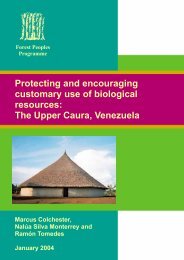Divers Paths to Justice - English - Forest Peoples Programme
Divers Paths to Justice - English - Forest Peoples Programme
Divers Paths to Justice - English - Forest Peoples Programme
You also want an ePaper? Increase the reach of your titles
YUMPU automatically turns print PDFs into web optimized ePapers that Google loves.
<strong>Divers</strong> <strong>Paths</strong> <strong>to</strong> <strong>Justice</strong>: Legal pluralism and the rights of indigenous peoples inSoutheast Asiaforeign plantation owners.The primary focus of demarcation of native land rights from 1913 onwardwas the surveying and registration of land kept under permanent cultivationonly. 12 This emphasis on native lands under continuous cultivation showsonce again a blatant disregard for the various ways in which natives couldclaim land, as documented in the Proclamation III of 1889 and the LandLaws of 1913. In the reports of the Land Settlement Department it wasmade clear that settlement officers found the demarcation of native rightsother than permanent agriculture far <strong>to</strong>o confusing <strong>to</strong> undertake. As theCommissioner of Lands, G. C. Woolley, reported in 1915, “At present thestate of affairs with regard <strong>to</strong> titles other than those for native-owned ricefields is somewhat chaotic.” Consequently, Company administra<strong>to</strong>rs foundit convenient <strong>to</strong> describe land in fallow or secondary forests as un-owned,empty, waste, abandoned or useless. 13During the settlement of native rights, natives were asked <strong>to</strong> clear theboundaries on their permanent agricultural land. But the district officerswhose job it was <strong>to</strong> oversee land settlement were plagued by difficulties.There are numerous accounts in the Company papers detailing the distric<strong>to</strong>fficers’ struggles with land settlement. The letters describe many instancesof both passive and active resistance on the part of the natives; it was notunusual for inhabitants of a village <strong>to</strong> fail <strong>to</strong> be present on the assigned daywhen the surveyor was available for boundary marking. 14 This reflects thelocal perception of the survey process as inherently disempowering. Unable<strong>to</strong> stake their claims through their presence, they resisted by makingthemselves absent.Company officials persisted in the task of land settlement, howeverfragmentary the results, hoping <strong>to</strong> overcome resistance by gaining the12 ‘Annual report on the land settlement for 1914’, CO874/797.13 Woolley’s comment is in ‘Recommendation of Governor Parr re: settlementwork’, 4 Feb. 1915, CO 874/797.14 ‘Annual report on land settlement, 1916’, CO874/797.; examples of letters are inNorth Borneo Company Archives #1356.88
















